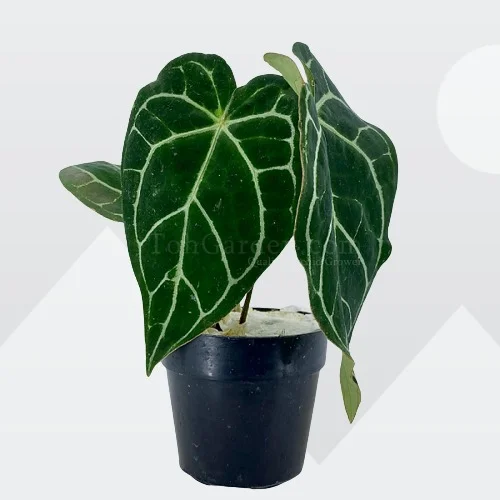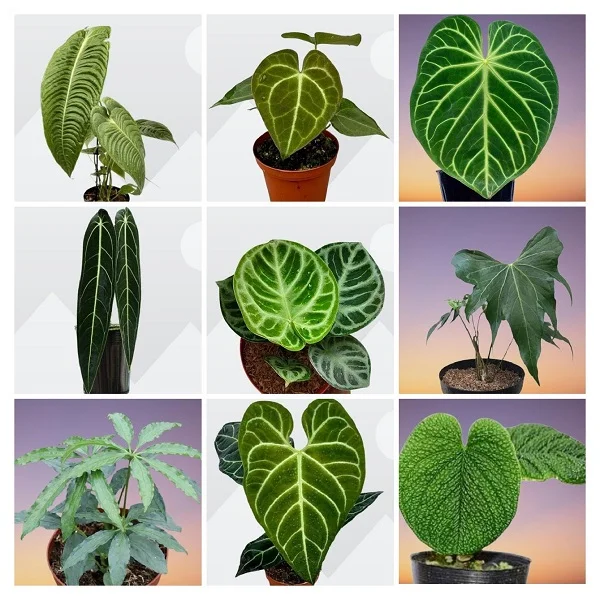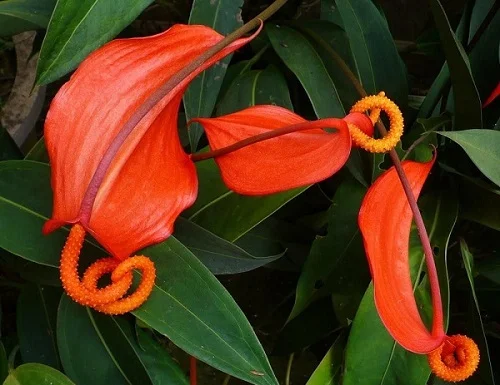Why Are My Anthurium Leaves Turning Brown? 10 Causes & Solutions
Some links in this post may be affiliate links
Anthurium brown leaves may be due to incorrect watering, too little light, improper feeding, poor quality soil, being root-bound, pests, diseases, hot temperatures, age among others.
Anthuriums are popular plants on account of their ability to adapt to a wide range of growing conditions. Most Anthuriums are grown for their spectacular foliage but a few are grown for their beautiful and striking flowers. Check out these popular Anthurium varieties that you can grow successfully.
Brown leaves in your Anthurium Plant are an indication that the growing conditions are wrong. Below we have discussed 10 causes of brown leaves in Anthuriums and how to fix them.

10 Common Causes of Anthurium Brown Leaves
1. Too Little Light
Sufficient light is needed for making food that is required for energy and growth of the plant. If the light is too low the plant cannot make enough food for energy and growth. In an attempt to save energy, the plant begins to die from the leaves which turn yellow, brown and eventually die.
Solutions
Position your Anthurium Plant in a brighter spot where it will receive bright indirect light. You may instal a grow light if natural light in your home is not adequate..
Regularly rotate the pot to ensure that the plant absorbs enough light for photosynthesis on all sides and also avoid leggy growth. Check out this guide on understanding light for houseplants.
2. Incorrect Watering
Overwatering Anthurium Plant will lead to soggy soil (excess water in the soil). Too much water in the soil reduces the oxygen concentration in the rootzone. This causes the roots to die due. When roots die, they cannot take up water to the leaves, they wilt due to dehydration, turn brown and begin to die.
Underwatering means that there is too little moisture in the soil for the plant to take up to the leaves. As such, the plant cannot take up nutrients and water to the leaves. Therefore, they wilt, turn brown and begin to die.
Solutions
Water your Anthurium liberally during the growing season until it comes out through the drainage holes while allowing the top 1-2 inches of soil to dry out between waterings. Cut down on watering in the cold season to maintain the soil slightly moist but do not let the soil dry out completely. Read more on how to water houseplants the right way.
3. Root Rot Disease
Root rot disease is characterized by wilting and yellowing leaves and is rapidly followed by browning of leaves and death of the plant. The disease is a fungal decay which is promoted by soggy soil brought about by poor soil drainage.
Solutions
Carefully slip the plant out of its pot and inspect the roots. Brown-black mushy roots indicate root-rot, trim them off and treat the healthy roots with a fungicidal solution.
Disinfect the pot with the fungicidal solution or use a fresh pot to repot the plant in fresh free-draining soil. Do not water the plant and keep it dry for some time before resuming watering.
To avoid getting soggy soil, ensure that the pot has a drainage hole and the soil is free-draining. Allow the top 1-2 inches of soil to dry out between waterings to keep the soil moist but not soggy. Decrease watering in the cold season to maintain the soil slightly moist as growth is minimal at this time. Learn more on how to treat root-rot in houseplants.

4. Pest Infestations
Anthuriums are prone to spider mites, aphids and fungus gnats. These pests attack the new growth from where they suck the plant sap. This causes the plant to become dehydrated and results in wilting and browning of the leaves.
Solutions
Regularly inspect your Anthurium Plant for these pests and take timely control measures. Isolate the affected plants and treat it with horticultural oil or insecticidal soap as per the manufacturers instructions.
5. Poor Quality Soil
Poor quality soil does not drain easily and therefore it easily becomes compacted or soggy which can negatively impact the growth. Such soils hold excessive amounts of water and can lead to yellowing, browning and dropping leaves.
Solutions
Pot and repot your Anthurium Plant in good quality soil that is loose, well-drained and rich in organic matter. Most potting mixes designed for aroids are ideal for Anthuriums.
6. Being Root-bound
If the plant is extremely root-bound, the roots have filled the pot and there is very little soil to hold water when you water the plant. Therefore, there is no water for the plant to take up to the leaves. The leaves loss their stiffness and they wilt, turn brown and begin to droop.
Solutions
Check the bottom of the pot for roots growing through the drainage hole and repot the plant into a pot one size larger than the current one. Make sure that the pot has a drainage hole and that the soil is loose and well-drained. Thereafter, repot your Anthurium every 2-3 years at the beginning of the growing season. Check out these self watering planters with drainage hole on Amazon.

7. Repotting Shock
Repotting may cause your plant some shock which may lead to some leaves wilting, turning brown and drooping before it can adjust to the new growing conditions.
Solutions
To minimize repotting shock, water your Anthurium Plant thoroughly one day before repotting. A well hydrated plant experiences less repotting shock. Do not make too many changes at once. For instance, after repotting, maintain the plant in the same location until it is well established before moving it to a new location.
8. Improper Feeding
Overfeeding will cause the roots to die due to fertilizer burn. When the roots die, they cannot take up water to the leaves. Without adequate water, the leaves get dehydrated, they wilt, turn brown and die.
Underfeeding implies that the plant is not getting enough nutrients need for growth and energy. Inadequate nutrients in the actively growing tips causes nutrients to be withdrawn from the older lower leaves which turn yellow, brown and drop.
Solutions
Take care not to overfeed the plant. Feed your Anthurium Plant during the growing season with a balanced, water-soluble fertilizer and follow the instructions on the label. Do not feed in the cold season as growth is minimal at this time and feeding at this time can lead to fertilizer burn.
Flush out accumulated salts from the soil regularly by running a stream of water through the soil until it comes out through the drainage holes. Repeat the process several times to leach out most of these salts from the soil. Read more on how to feed houseplants.
9. Extremely Hot Temperatures
Extremely hot temperatures will negatively affect the growth of Anthurium Plant. Very high temperatures will cause dehydration resulting in wilting and browning of the leaves.
Solutions
Keep your Anthurium away from hot drafts from hot surfaces, hot air vents and other hot areas to prevent extremely high temperatures. Maintain an average temperature of 18-270C. A room temperature that is comfortable for you is ideal for this plant. Check out this guide on understanding temperature for houseplants.
10. Aging
As the Anthurium Plant matures, it loses the lower leaves which turn yellow, then brown and eventually die.
Solutions
Remove yellow, brown and dead leaves to maintain your Anthurium neat as well as discourage pest and disease infestations. Cut the leaves at the base of the stem with a sharp sterilized knife or with a sharp, clean pair of pruning scissors to avoid unnecessary injury which can result in disease infestation.
Summary: Preventing Brown Leaves in Anthurium
To keep your Anthurium healthy, follow these preventive measures:
- Use well-draining soil and pots with drainage holes.
- Water consistently but avoid overwatering.
- Place your plant in bright, indirect light to prevent sun damage.
- Keep humidity above 50% to mimic its natural environment.
- Maintain an average warmth and keep your plant away from drafts.
- Feed with a gentle, balanced fertilizer as indicated by the manufacturer.
- Repot once you see roots growing through the drainage holes.
- Regularly inspect your plant for pests and diseases and carry out timely control measures.
Conclusion
Brown leaves on your Anthurium can be alarming, but with proper care and adjustments, you can restore its health. By identifying the cause, maintaining proper humidity, watering correctly, and ensuring good nutrition, your Anthurium will thrive once again.
Frequently Asked Questions
1. Why are my Anthurium leaves turning brown and yellow at the same time?
Usually, this is a sign of overwatering or a nutrient deficiency. Check the soil and adjust watering habits.
2. Can I cut off the brown leaves from my Anthurium?
Yes, trimming Anthrium brown leaves helps redirect energy to healthier growth. Use clean scissors to remove damaged leaves.
3. How often should I water my Anthurium?
Do not water on a schedule. Always feel the soil before watering. Allow the top few inches of soil to dry out between waterings.
4. What kind of soil is best for Anthuriums?
The best soil for Anthuriums is a well-draining mix with peat, perlite, and orchid bark is ideal to prevent root rot.
5. Does misting help with brown leaves?
No. Misting does not help with brown leaves and it should not be done as it increases occurence of fungal diseases. You may group the plants together, set the pot on a wet pebble tray or use a cool mist humidifier to increase humidity.
6. Can fertilizer cause brown tips on Anthurium leaves?
Yes, excessive fertilizer can result in salt buildup which causese brown leaf tips. Flush the soil regularly with clean water to remove excess salts.
You liked it? Share on social media.
Related Content
Amazon Associates Disclosure
Homeplantsguide.com is a participant in the Amazon Services LLC Associates Program, an affiliate advertising program designed to provide a means for sites to earn advertising fees by advertising and linking to amazon.com.





